KitKat Milk Chocolate with Crisp Wafers
|
KitKat Milk Chocolate - is it a candy, or is it a cookie? You decide. Personally, I’d say the answer is, “Yes.” It’s in the undefined middle between candy and cookie, so I think it’s fair to say, “both.” Really, though, the more important question is whether you like it. One of the things that sets KitKat apart is it’s one of the minority of chocolate bars that has crunch. So, if a chocolate bar with crunch is what you’re looking for, you’re on the right track. KitKat comes in a well-sealed plastic wrapper for good keeping under varied shipping conditions. There are three layers of crisp, crunchy wafers in a KitKat Milk Chocolate bar, separated by thin layers of what I would describe as frosting ;-) , encapsulated in milk chocolate. The wafers are pretty similar in texture to regular ice cream cone material. The bar has four pieces like this, connected at the base by only chocolate (no wafers) so that the pieces can be easily separated. There is a dark chocolate version of KitKat, but it’s harder to find because in the U.S. we eat more milk chocolate and less dark. |
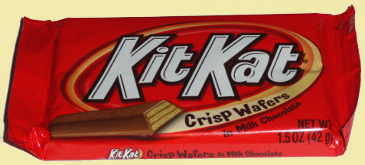 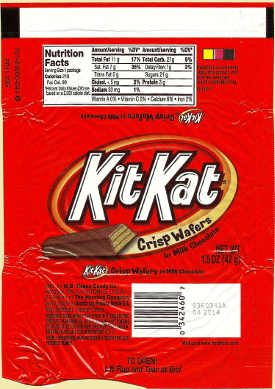 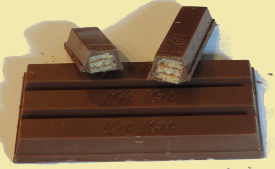 |
KitKat Milk Chocolate Ingredients and Nutrition
|
The nutrition label gives the
serving size as one package, with 210 calories. So if you can limit
yourself to a single section for a mini-snack, that’s just 52 calories!
Here’s a possible advantage of the wafers: put half a section in your
mouth, slowly let the chocolate melt off, then lick the frosting off the
wafers, then crunch the wafers. Presto, you’ve just stretched 26 calories out to over a minute, maybe even two. Hey, it may work - just depends how ravenous you’re feeling! KitKat Milk Chocolate has fourteen ingredients. Personally I tend to get progressively more suspicious of a food product’s nutritional quality as the ingredient list lengthens. Especially when it contains anything I have to research to find out what it is. In this case, that was “PGPR.” According
to Wikipedia, PGPR stands for polyglycerol polyricinoleate, which would
have set off my other suspicion alarm - anything I can’t pronounce.
They go on to define PGPR as a yellowish, viscous liquid composed of
polyglycerol esters either of polycondensed fatty acids from castor oil
or of dimerized fatty acids of soybean oil. Got that? Yeah - me neither. Well, at least it's in the "less than 2%" section of the list. Also, it’s not like KitKat is the only one using PGPR. It’s used in a lot of popular chocolate products to make the melted chocolate less viscous - easier to pour. In this case so that it’s easier to coat the wafers with chocolate. Besides, if it were really bad for us, the FDA would make them stop using it. Right? On the good side, there’s only one sugar in this list (well, except a little milk sugar (lactose) six steps further down the list) and it’s actually sugar, not one of the cheaper versions. |
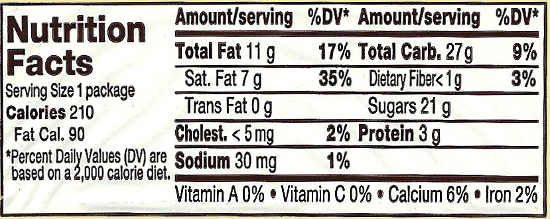 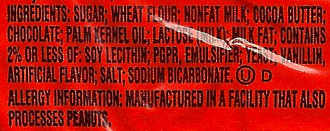 Since I had difficulty getting a good picture of the ingredients list on the label, here’s the transcript: INGREDIENTS:
CONTAINS 2% OR LESS OF:
|
I paid $1.19 for this 1.5-ounce KitKat Milk Chocolate bar (May 2013). For comparison purposes, that's $12.69 per pound. This pretty much in the same ballpark as most popular chocolate bars.
I'm giving this my personal score of 3.2 out of 5 stars for Overall Enjoyment, 3.0 for Nutrition, and 3.1 for Value. Keep in mind this is just my personal opinion. Your mileage may vary, and there's no accounting for taste.
Now you know what a KitKat is.
Any questions? You know where my Contact Page is!
Home More Chocolate Bars KitKat Milk Chocolate (top)




